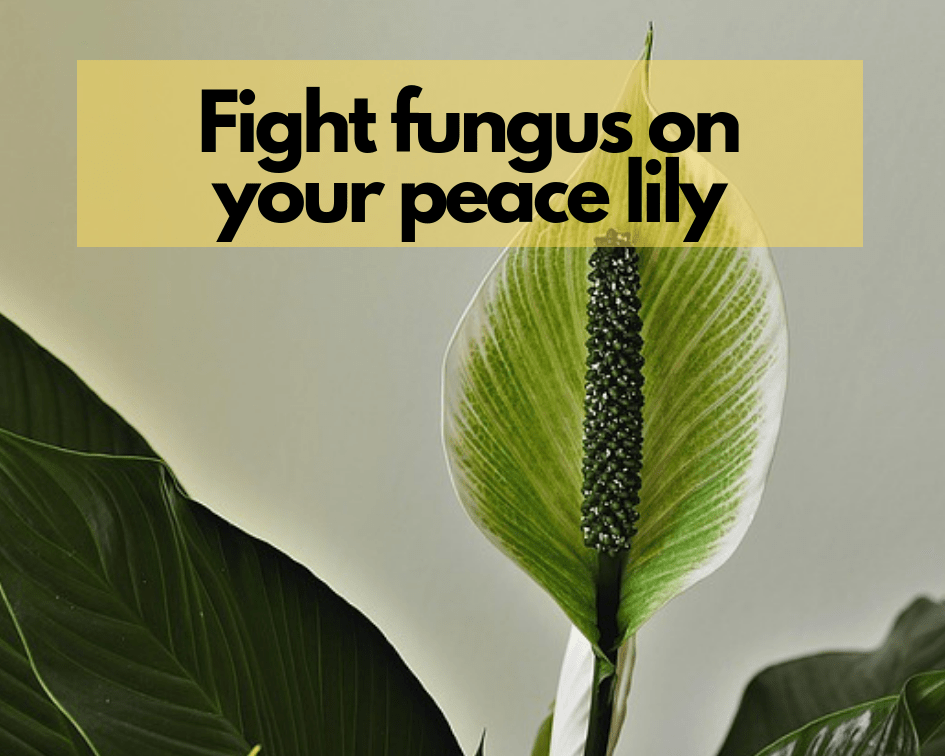This post may contain affiliate links. As an Amazon Associate we earn from qualifying purchases.
Peace lily fungus and how to battle it!
Few plants feel so at home in the shadier corners of the house, than the peace lily. Not only does the foliage remain healthy and strong, but it produces gorgeous tropical flowers as well.
This is why there is such a love affair between Americans and the Spathiphyllum spp, or peace lily as it is commonly known.
While there are several fungal pathogens that attack the peace lily’s roots, most of these occur in seedlings, while still in the greenhouse. If the peace lily’s foliage bears brown or black splotches, suspect a foliar fungus.
If, on the other hand, the leaves turn yellow, especially on the bottom of the plant, it may have a root fungus.
What you’ll need to fight peace lily fungus
- Foliar fungicide spray
- Fungicide soil drench

How to treat and prevent foliar peace lily fungus
Inspect the peace lily’s leaves to ensure that it is truly a fungal problem and not pests. To determine if it’s peace lily fungus, look for circular brown spots on the surface of the leaves and on the margins.
If it is similar to the photo above, meet Cephaleuros virescens, or green algal leaf spot. The spots aren’t always brown, but may also be orange, a bit on the gray side or green.
Spray the foliage, according to package directions, with a fungicide containing Bacillus amyloliquefaciens as the active ingredient. Arber, below, fits the bill.

Avoid fungus on the peace lily’s foliage by watering slowly to avoid splashing water and soil on the leaves. Don’t mist the plant’s foliage. Place the Spathiphyllum in an area with good air circulation such as next to a fan, or near an open window.
Treat peace lily root fungus
Cylindrocladium spathiphylli is among the two most common fungal pathogens of the peace lily. Act quickly at the first sign of root rot – the yellowing of bottom leaves. Check the leaf petioles (leaf stalks that join the stem) as well, looking for black specks. If left untreated, the plant will collapse and die.
Drench the soil with a fungicide containing thiophanate-methyl (available on Amazon.com), according to the instructions printed on the fungicide’s label. Be aware, however, that “Chemical treatments are not completely effective unless …” you catch the disease in the very early stages, according to R.J. Henny, A.R. Chase and L.S. Osborne at the University of Florida, IFAS.
Avoid root rot by not over-watering the Spathiphyllum. Don’t allow water to sit in the saucer after watering. Over-fertilizing the plant also makes it more susceptible to root fungus, according to the experts at Michigan State University.
Tip: If you have trouble diagnosing fungal problems take a leaf sample to your county cooperative extension agent. Find yours, here.
Warning: To avoid spreading the disease to other plants, wash your hands after working on the infected peace lily. While researchers claim that they’ve yet to find anything that will completely stop the infection, studies from the University of Florida suggest that Cleary’s 3336 F (linked to above) was most successful at controlling it.
Pythium Root Rot
Yup, another nasty root infection for your prized peace lily. This one comes from Pythium spp., once thought to be a fungi, but now classified as a parasitic oomycete . This root rot differs from that caused by Cylindrocladium spathiphylli in that it doesn’t attack the leaf petioles.
Symptoms include wilted, chlorotic foliage. If you remove the plant from its pot you’ll see black, mushy roots. By then, it’s too late for the plant.
Prevention includes cutting back on water. Peace lilies prefer a dryer soil anyway. Avoid the urge to overwater.
Learn more about Pythium root rot of peace lily at the University of Hawaii’s website.
A species of the bacterium Bacillus, amyloliquefaciens, is considered effective against pythium. It is the active ingredient in Arber Biofungicide, mentioned earlier.
Warning: Do not use any fungicides containing iprodione on the peace lily
Resources
Peace Lily ‘Sensation,’ Live Plant
Peace Lily ‘Sweet Pablo,’ Live Plant







